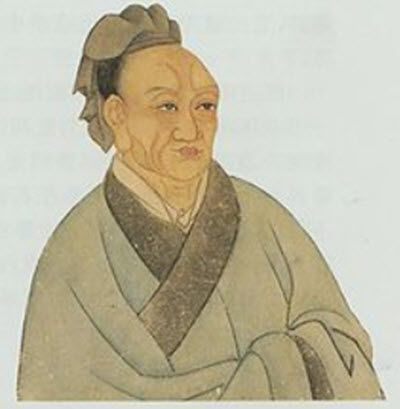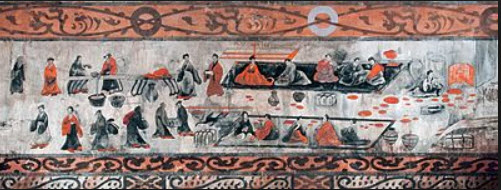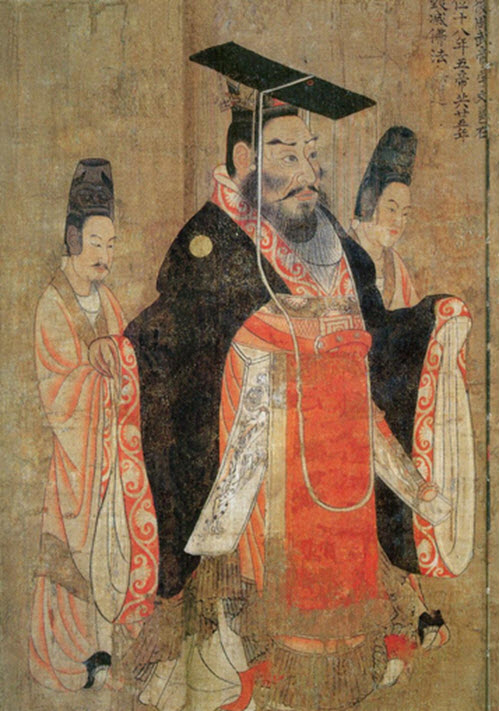Contents
Chan Chi’ien hears about Buddhism in the 2nd century BC
 One early record describes that the Chinese diplomat Chan Chi’ien , who had just returned from Ta-hsia (Ferghana, in today’s Uzbekistan), had learned of a country named Tien-chu (India) and their religious Buddhist teachings. Chan Chi’ien, also known as Zhang Quian, was a Chinese oficial and diplomat who served as an imperial envoy in the 2nd century BC. For the Emperor Wu of Han, he was a very important source of information about the world outside China, especially Central Asia along the Silk Road. His journeys helped connect China with the many surrounding kingdoms and their products, and he also helped expand certain Central Asian sections of the Silk Road
One early record describes that the Chinese diplomat Chan Chi’ien , who had just returned from Ta-hsia (Ferghana, in today’s Uzbekistan), had learned of a country named Tien-chu (India) and their religious Buddhist teachings. Chan Chi’ien, also known as Zhang Quian, was a Chinese oficial and diplomat who served as an imperial envoy in the 2nd century BC. For the Emperor Wu of Han, he was a very important source of information about the world outside China, especially Central Asia along the Silk Road. His journeys helped connect China with the many surrounding kingdoms and their products, and he also helped expand certain Central Asian sections of the Silk Road
1st century BC
As early as the first century BC, a Buddhist community existed at the court of one of the Han provinces.
Emperor Mingdi dreams about Buddha
In 68 AD, Han Emperor Mingdi had puzzling dream about a golden figure. The morning after, he told his ministers of the dream and asked what it ment, and they suggested that he had seen a vision of Buddha – God of the West.
The emperor got curious to know more and dispatched an official named Cai Yin to Central Asia to learn about Buddhism. After three years, Yin returned, bringing back not just information about Buddhism but also two Buddhist monks named She-mo-teng and Chu-fa-lan that were willing to teach Buddhism in China. Yin also presented images of Buddha and Buddhist scriptures to the emperor.
The White Horse Temple in Luoyang
The first Buddhist temple in China, a temple known as the White Horse Temple, was built in the first century AD in Luoyang, which was the capital of the Eastern Han Dynasty and a focal point of China. The temple still exists, although it has undergone many changes throughout the centuries and most of the structures that now exist are from the 1500s. For a long time, Luoyang was seen as the eastern starting point for the Silk Road.
Luoyang became an important center for dispersing Buddhism to other parts of China, and it held a rich assortment of Buddhist books, texts and art.
An Shih-kao
In 148 AD, the Parthian missionary An Shih-kao arrived to Luoyang and started working on translating Buddhist texts to Chinese. After him, others took over, and the practise of translating Buddhist texts into Chinese continued here until the 8th century when China’s land connection to Buddhists in Central Asia and Inda was cut off by the Arabs.
Emperor Huan
 In 166AD, the Han Emperor Huan had both Buddhist and Taoist ceremonies carried out in the imperial palace.
In 166AD, the Han Emperor Huan had both Buddhist and Taoist ceremonies carried out in the imperial palace.
Examples of translators
Here are some examples of notable Buddhists who worked in China translating Buddhist texts into Chinese during the second, third and early fourth century AD.
| Name | Origin | Info |
| An Shih-kao | Parthian | Early Buddhist missionary to China.
Lived circa 148-180 AD. Alledgedy a prince of Parthia that renounced his claim to the throne to be a monk. |
| An Hsuan | Parthian | Originally a Parthian merchant; became a Buddhist monk in China 181 AD. |
| Lokaksema | Yueh-chih | Active 147-186 AD
Born in Gandhara when it was a center of Greco-Buddhist art. Translated a number of Mahayāna Buddhist texts into Chinese. |
| Chih-yao | Yueh-chih | |
| K’ang Meng-hsiang | Sogdia | His ancestors were from K’ang-chu |
| Chih Ch’ien | Yueh-chih | His grandfather imigrated to China in the 2nd century AD. |
| Chih Yueh | Yueh-chih | Worked i Nanjing. |
| K’ang Seng-hui | Sogdia | Born in Chiao-chich.
His faterh was a Sogdian merchant. |
| Tan-ti | Parthian | |
| Po Yen | Kuchean | Kuchean prince |
| Dharmaraksa | Yueh-chih | His family had imigrated to Dunhuang generations ago. |
| An Fa-chi’in | Parthian | |
| Po Srimitra | Kuchean | Kuchean prince |
Kumarajiva
During the 4th century AD, the Central Asian Buddhist Kumarajiva set ut a translation bureau that became very productive, translating approximately a hundred Buddhist works from various languages into Chinese. 52 of them have survived into our time and are included in the Buddhist canon.
The Sui and Tang dynasties

Data from around 514 (which is before the start of the Sui dynasty in 581) show that at that point, there were roughly 2 million Buddhists living in China.
During the Sui dynasty (581-618) and Tang dynasty (618-907), Buddhism was widespread in China and the religion and its ceremonies had trickled down from the courts and learned centers to ordinary folks in various parts of the country. A lot of Buddhist monasteries had been established and marvelous temples had been erected.
Numerous Buddhist pilgrims and missionaries came to China from other parts of Asia, and China also sent pilgrims to India along the Silk Road. Some of the more notable among the Chinese pilgrims were Xuan-Zang and I-Tsing; both active during the 7th century.
A notable setback for Buddhism in China took place in 845, when Chinese Buddhists were subjected to widespread presecution, with over 260,000 monks and nuns being defrocked and an estimated 4600 temples destroyed.
Chinese Buddhists introduces the religion to Korea and Japan
Buddhism, in its Chinese form, spread first to Korea and then into Japan during towards the end of the 700s.